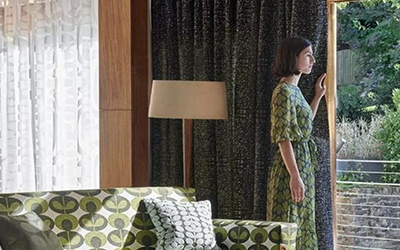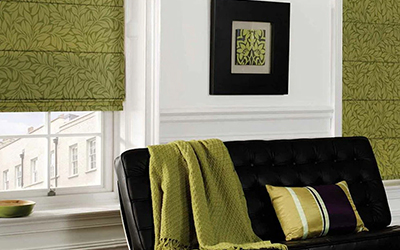How to make a roman blind from a kit
Decide what size you require your roman blind.
Step Two: Joining your fabric and lining.
Inside The Recess: Measure at three points across the width and down the drop, take the smallest two sizes and deduct 1cm from the width and 0.5cm from the drop.
Outside: Measure your window recess and allow an overlap, we usually add 10cm to the width and 5cm to the drop, and fix the blind 5cm above the top of the recess which makes the bottom hem of the blind level with the window sill.(you can go below if you like just add more to the drop.)
Our example blind is 100cm wide by 100cm drop. (100cms square)
Step One: Cutting the fabric.
Once you have your sizes, cut your face fabric 5cm wider than the finished blind size and cut minimum 15cm longer than the drop. For our blind that is 105cm wide 115cm drop. Cut your lining exactly the same width as your finished blind width and 15cms longer. For our blind that is 100cm and 115cm drop.
Place your face fabric on a flat surface facing up, and your lining on top of it facing down, pin the two together down the sides keeping the sides level with each other. Sew down both sides of the blind exactly 1cm in from the edge (mark with a light pencil line if needed.) Turn your blind through and check the width measurement it should be correct. Place your blind on an ironing board ensuring the seam is fold inwards towards the center of the blind and lightly press. this will ensure a nice straight edge to your blind.
Step Three: Attach velcro and finish the top of the blind.
With your blind joined and turned the right way out lay it down on a flat surface ensuring it has no creases and is square at the top edge. Mark a line 1.5cms down from the top of the blind fold over and pin in place. Sew your velcro over the folded down fabric, keeping the top edge of the velcro slightly below the top of the blind.
Step 4: Mark out rods pocket spacing's and attach rod pockets.
To work out the rods pocket spacing's take the drop of your blind, our's is 100cms, deduct 5cms = 95cms. Decide how many pockets you want in your blind, we want 3 so we double this number and add 1, = 7. (if you require 5 rods you would divide by 11)
Your first rod pocket is drop(100cms), minus 5cms (95cms) divide by 7 (13.57cms) multipy by 2 (27.14) plus the 5cms (32.14cms). This equals 32.14cms distance from the top of the blind to the first rods pocket. The second rod pocket is 27.14 cms below the first and the third is 27.14 cms below the second one and so on. (After the first rod pocket any subsequent ones are the drop minus 5cms, divide by 7 multiply by 2.)
The number of rods in each blind is optional we recommend the following:
upto 125cms drop = 3 rods.
125cms to 160cms 4 rods.
160cms to 195cms 5 rods.
195cms to 230cms 6 rods.
230cms to 265cms 7 rods.
265cms to 300cms 8 rods.
Mark the rod pockets spacing's onto the lining using a light pencil mark, pin on your rod pocket tape leaving 2cms hanging off either side, then carefully stitch along the top of the roman blind tape. The woven loops should be facing you, the control cords pass through these later.
Step 5: Bottom pocket.
Measure from the top of the blind to the required drop, in our case 100cms, mark a straight line across the full width of the blind. Mark another line 3.8cms below your first and then a third line 3.8cms below the second line. Cut along the third(bottom) line. Then fold up from the bottom to the second line, and fold again to the first line, which is the drop of the blind. Pin this pocket in place. Check the drop of your blinds. If all is well, sew along the top of the bottom pocket.
Step 6: Insert rods and bottom bar.
Cut your rods and bottom bar the the correct width. The bottom bar should be 1cms narrower than the blind, and the rods should be the same width as the lining on the back of your blind. Insert the bottom bar into the pocket you have sewn into the bottom of your blind. Insert the rods into the rods pocket (it is a tube) and tack the ends closed with a needle and thread.
Step 7: Attach headrail and cord the blind:
Lay your blind face down and flat on a level flat surface. Attach to the headrail by pressing the velcro along the top of your bind to the velcro in the headrail. Equally space the cord barrels in the headrail across the width of your blind. This can be done by lossening the clampings screws and sliding into position. When correct re tighten the screws to lock the barrels in place. Thread the cords down through the loops in the rod pocket tapes, don not thread through the bottom rods pocket.
Attach the spring loaded child safe cord collectors to the bottom rods pocket using the hook, ensure the collectors are directly below each control cord. Press the button on the back of the cord collectors and hold whilst threading through the control cord, ensure you leave no slack in the cord. Release the button and the cords will be held captive.
Step 8: Fixing the control chain.
Cut/trim your control chain to be 5 cms shorter than the drop of your blind.(our blind is 100cms drop so we cut the chain 190cms) Join the chain using the child safe chain connector supplied. Remove the 2 screws which hold the cover on the winder unit on your roman blind headrail. Place the chain over the cog inside, making sure the child safe chain breaker is at the front and two fifths (40%) of the way down the front of the blind, on our blind that would be 40cms down from the top. Replace the end cap and tighten the screws. By positioning the chain break in this way when you come to use your blind you will be able to pull the chain from above the join to raise the blind and above to lower the blind.
NB. The control chain can be shortened to 60% of the overall drop of the blind, if your blind comes down to the floor, please bear in mind that you will need to shorten the chain so it comes no closer than 60cms to the floor in order for your blind to be child safe.
Always fit the chain into the child safe "P" clip supplied.
Step 9:
Fixing the brackets and hanging your blind.
The brackets supplied are suitable to either face fix (to your wall or window frame) or top fix into the plaster inside the window recess. We have supplied some basic screws and plugs however you may need to find more specialist ones depending on the material you are fixing into. The brackets can be fixed anywhere along the top of the headrail and are not seen once the blind is installed, so you only need to roughly space them along the top of the blind.
Fixing to a wall (face) outside the recess.
Decide where the top of your blind will be, ensure the plaster work is flat and in good repair. Lightly mark the top position of your blind on the wall, place the fixing bracket onto the wall with the lever at the top and facing you, mark through the two fixing holes on the back leg of the bracket. Using a spirit level mark across the width of your blind using the top of the blind and your first brackets marks as a reference point. Drill and plug the wall, fix the brackets in place. Ensure all the levers are in the open position (at 90 degrees to the wall, slide the blind headrail over the front prongs on the brackets and tilt the headrail upwards at the back, close the brackets by pushing the the left.
Fixing to a wall inside (top) the window recess.
Check how far the window handles protrude from your window frame, your blind needs to be clear of them to raise up and down without catching. The We advise 3-4 cms clearance, so if you handles protrude by 3 cms you will need to fix the brackets 3 cms forward of the window frame as the distance from the back of the bracket to the fabric part of the blind is about 3.8cms. Mark 3 cms in from the window frame then place the back of your bracket up against the plasterwork mark through the fixing holes either side of the locking lever. Repeat across the width of the blind making the spaces roughly even. Drill and plug the holes and fix the brackets in place. Ensure all the levers are open, slide the blind headrail over the front prongs on the brackets and tilt the headrail upwards at the back, close the brackets by pushing to the left.
Fixing the child safe "P" clip (you must fit this in order to make your blind child safe.)
Place the "P" clip over the control chain and extend the chain downwards, do not place too much tension on the chain. Mark through the fixing holes into the window recess. Drill and plug if required and fix the "P" clip to the wall.
Buy Roman Blind Kits Click Here.









